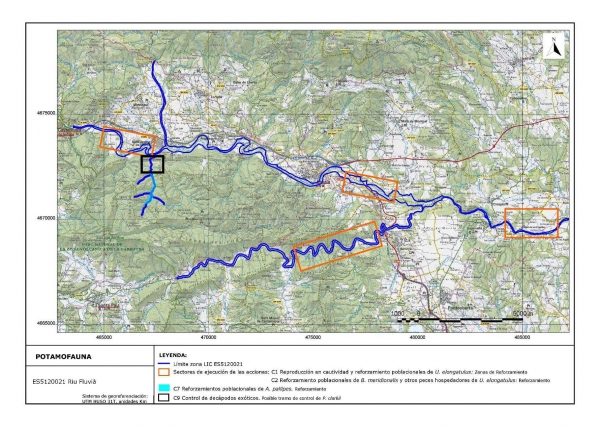River Fluvià
Surface: 1,323.600 hectares
The Natura 2000 Fluvià River (ES5120021) is a river space of Mediterranean riparian forests in good condition and works as an ecological corridor. Within the limits of the Natura 2000 area includes the Wildlife Nature Reserve of Fares Island in Fluvià River, declared by the Government of Catalonia. The River area has a great ecological and landscape value not being interrupted by any artificial reservoir water and pose a biological corridor between the Garrotxa Volcanic Zone Natural Park and SCI Alta Garrotxa with coastal areas and the natural Park of Aiguamolls. River Fluvià is the best representation in Catalonia of the Mediterranean river systems. It has riparian forests in very good condition, emphasizing its alder and holds the presence of otters (Lutra lutra) and Mediterranean Barbel (Barbus meridionalis).
The Fluvià is a river of eastern Pyrenees. It starts in the Garrotxa, el Grau d’Olot, 920 meters high and is 97.2 km long. Included in the main channel space nature of the river Fluvià, all of the main tributaries of the left side: the Llierca, the Ser, the Torrent and Ca n'Illa, and a section of the head of the stream Merdençà, a tributary of the River Ser. The head is oriented north-south and collects moisture east winds, which make it an important pluviometry (over 1,000 mm rainfall). The head of the river Fluvià is included in the Garrotxa Volcanic Zone Natural Park, and the section below the mouth of the Natural Park of Aiguamolls. The flow rate is 1.5 m3 per second in Olot, 8 m3 per second Esponellà and 10 m3 per second at the mouth. The system is essentially rain.
The working area of the project does not include all of the SCI space, but a big part in this space was eminently river. Here the project area focuses only on streams and rivers, involving an area centered around these environments in which they live aquatic species objective of the project.
The importance of the river Fluvià populations of target species of this project, essentially the Naiad Unio elongatulus and Mediterranena Barbel (Barbus meridionalis) is considerable, although difficult to quantify in terms of demography.
the Naiad Unio elongatulus. Its regression in Catalan Basins has been dramatic. The population of this species existing in the river Fluvià is one of the few well preserved ones, and in the whole basin of northeastern Catalonia. Apparently, despite being seriously threatened and in obvious decline, the population is also the best one in the basin, especially the population of the river Ser. In this context, the Garrotxa Volcanic Zone Natural Park (ES5120004) has devoted much effort to study the population of Unio Elongatulusand to experiment with reproduction in semi captivity, and to repopulate the river Fluvià within the boundaries of the park.
Actions have been implemented for the recovery of this species upstream, within the limits of the Natural Park of Volcanic Zone, and tracked between 2002 and 2011 the population of the river Ser. The presence of unknown Unio in other tributaries of the river Fluvià and Ser is still not fully understood but it’s known that there is potential habitat for these species.
Some actions are planned such as stocking with captive-bred breeding laboratory naiads in Consorci de l’Estany from parental individuals of the same river basin. Since there may be some genetic differentiation between basins and sub-basins, the units used must come from production lines based on the same parental space or spaces next within the same watershed. In each of these areas between 2 and 4 sectors will be chosen, where reinforcements will be conducted with youth naiads and infestations of wild fish with naiads. These sectors will be allocated based on information previously available on the general state of the rivers in the area of general scope of the project and the current understanding of the requirements of the species and the status of their populations. Chosen stretches of river with a stable river channel morphology, suitable courses, good water quality, scarce natural hydrological stress, general good ecological status and the presence of at least one species of native fish host, among other criteria.
Noted that in the area have not yet been identified as species Dreissena polymorpha and Corbicula fluminea, but it has been found Anodonta woodiana an invasive bivalve. The threat of these species in the wetlands of Catalonia is very high, even in stagnant water bodies such as lakes and marshes.
Mediterranean Barbel (Barbus meridionalis). This species is experiencing a gradual decline in the whole small distribution area, located in southern Europe. While still maintaining stable populations in dense areas or in some rivers, it has disappeared from many sectors, especially along the main river zones where has previously occupied. In the basin of the river Fluvià, Barbus meridionalis is still stable populations in some sectors, such as the river Ser, although it is generally in decline, having disappeared completely from the low-middle of the river.
The recovery actions for Barbus meridionalis in River Fluvià depend on your relationship with stock recovery Unio elongatulus. In places where it is intended to repopulate youth Unio elongatulus bred in captivity, studied the composition of fish, to ensure the presence of the guests for naiads such as Barbus meridionalis, Squalius laietanus or Salaria fluviatilis. In case of not having the presence of these species, reforestation run occasional Barbus meridionalis.
Austropotamobius pallipes (Austropotamobius pallipes). Catalogue of threatened fauna of Catalonia (pending approval) species considered endangered (its short-term survival is unlikely). Wide distribution in Catalonia, but very localized mainly in small creeks and streams undisturbed. The location of the river Fluvià crab is testimonial, with a single locality scattered in a tributary stream. The populations are located in upper and second order streams where due to a natural barrier (drought, cliffs ...) Crayfish plague the fungus has not been reached. Currently populations suffer the threat of the spread of crayfish.
This space also has joined the project to conserve populations of White-clawed crayfish (Austropotamobius pallipes). The precise details about the process of reproduction in captivity of Austropotamobius pallipes are found in the corresponding protocol established in accordance with the objectives of the project. One of the special conditions to be included in this protocol is the maintenance of breeding lines for each separate area of origin of the parental units. The reinforcements population will be carried out in appropriate sectors of the SCI included in the performance area of the project. In the sectors where the species has disappeared, but always within LIC where still present, this will enable the establishment of new populations are at least 1 in every LIC.

















